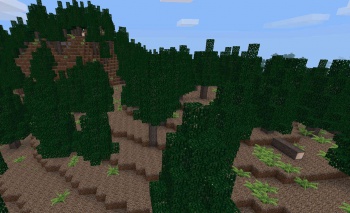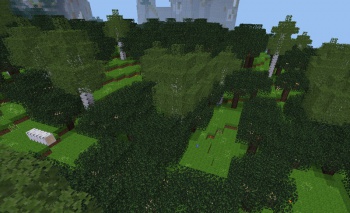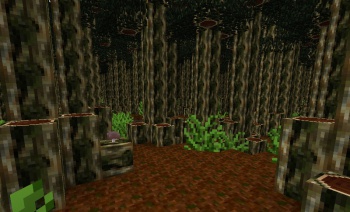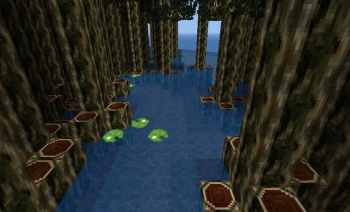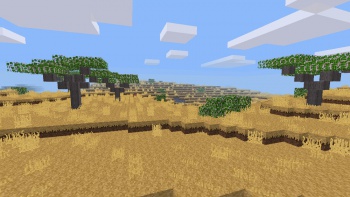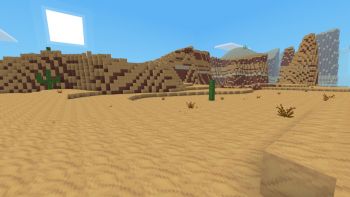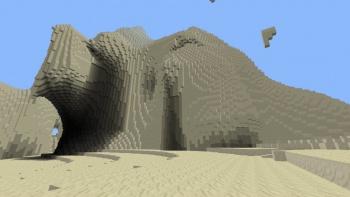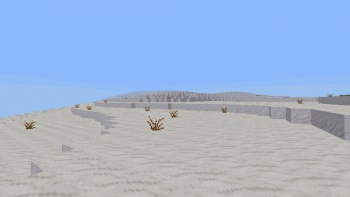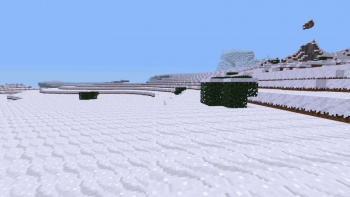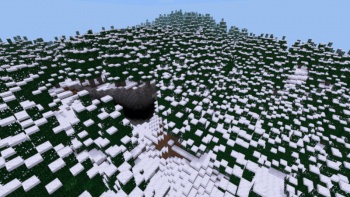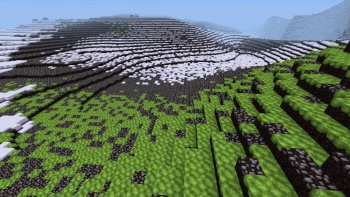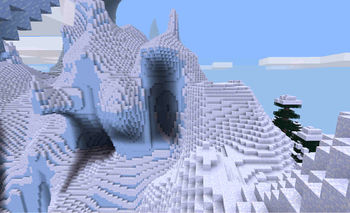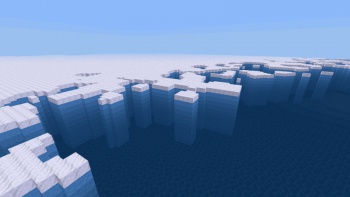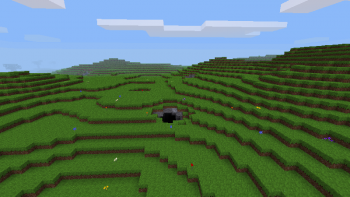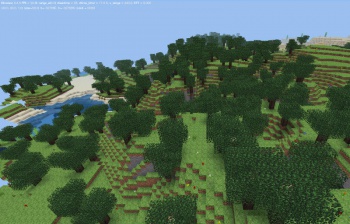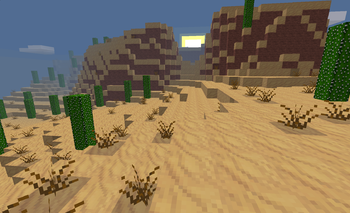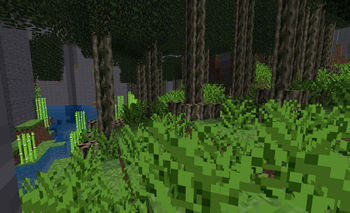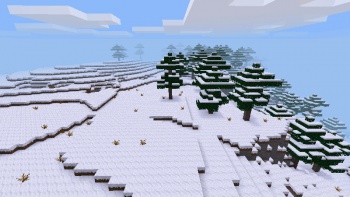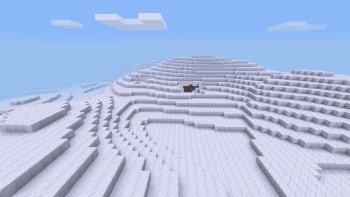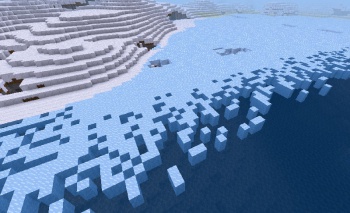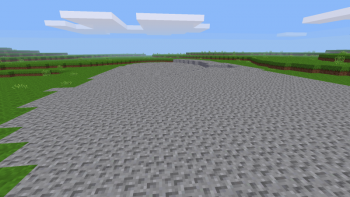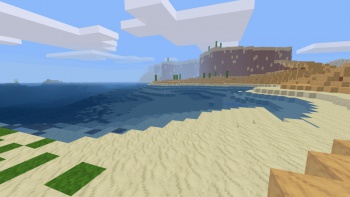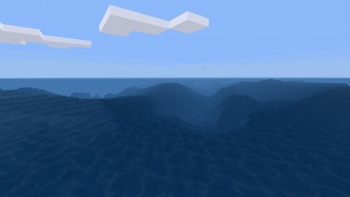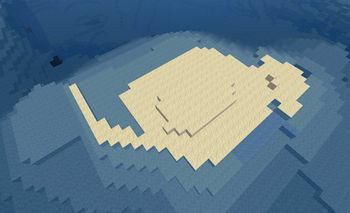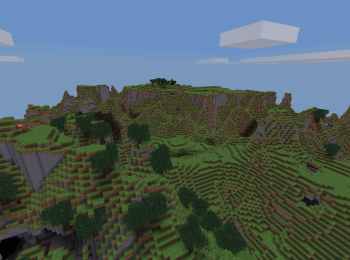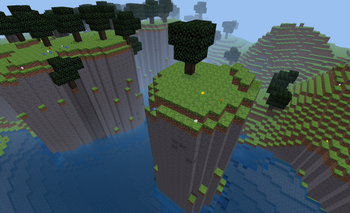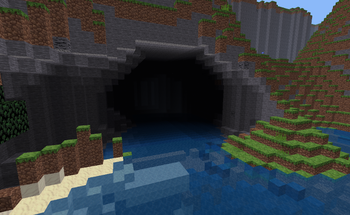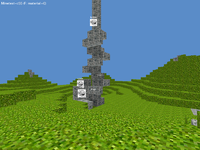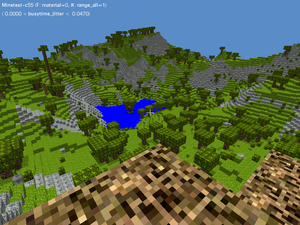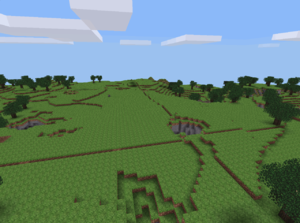Biomes
| English • Deutsch • français • Bahasa Indonesia • 日本語 • Bahasa Melayu |
Biomes in Minetest are a part of the map generation. Biomes are areas with similar ground and underground and vegetation.
Biome types
The biomes depend on the map generator used. Most map generators have the same biomes, but v6 is different.
v5, v7, valleys, flat, fractal
Biomes in these map generators are defined by mods. If these are not defined, these map generators only generate stone worlds. Biomes in these map generators are not linked to the terrain shape; this means any biome (including grasslands) can form in flat or very mountainous areas. This section shows the biomes used by Minetest Game.
| Name and Features | Description | Images |
|---|---|---|
| Grassland Stone, Dirt, Dirt with Grass, Grass, Flower, Bush Leaves, Bush Stem |
Grassland has large amounts of Dirt nodes and Dirt with Grass blocks, on which flowers, Grass and bushes may appear naturally in this area. The underground is made of stone. | |
| Coniferous forest Stone, Dirt, Dirt with Grass, Pine Tree, Pine Needles, Grass, Flower, Red Mushroom, Brown Mushroom |
Coniferous forests grow in colder areas and are filled with pine trees. Pine tree forests can also be covered with snow in cold regions. | |
| Deciduous forest Stone, Dirt, Dirt with Grass, Tree, Leaves, Aspen Tree, Aspen Leaves, Apple, Red Mushroom, Brown Mushroom, Bush Leaves, Bush Stem |
Deciduous forests are one of the most common biomes in Minetest and form in temperate zones. Trees, apple trees and aspen trees grow here naturally. Generally forests can spawn lakes, ponds, and rivers inside of it. Deciduous forests usually surround plains. | |
| Rainforest Stone, Dirt, Dirt with Rainforest Litter, Jungle Grass, Jungle Tree, Jungle Leaves, Brown Mushroom, Waterlily |
Rainforests (or jungles) are made of large jungle trees which grow thickly packed together. Jungle Grass and Jungle Trees bearing Jungle Leaves spawn here naturally. On fallen jungle tree logs, brown mushrooms may appear rarely. Jungles near oceans form a swamp with waterlilies. | |
| Savanna Stone, Dirt, Dirt with Dry Grass, Dry Grass, Acacia Tree, Acacia Leaves, Acacia Bush Leaves, Acacia Bush Stem, Waterlily, Papyrus |
The savanna is a dry land which is not a desert, it is populated with acacia trees and dry grass. Flat water bordering to savannahs is likely to have waterlilies and papyri. | |
| Desert Desert Stone, Desert Sand, Cactus, Dry Shrub |
Deserts contain large amounts of desert sand and desert stone. Cacti and dry shrubs also spawn here naturally on desert sand. Cacti can form in two different shapes. Deserts form in hot and dry areas. | |
| Sandstone desert Sand, Sandstone, Dry Shrub |
Sandstone deserts are large barren areas covered by sand with sandstone below. They form in temperate and dry climates. | |
| Cold desert Silver Sand, Stone, Dry Shrub |
Cold deserts are large barren areas covered by large amounts of silver sand on top of stone. They form in cold and dry areas. | |
| Snowy grassland Stone, Dirt, Snow, Dirt with Snow, Bush Leaves, Bush Stem |
The snowy grassland biome usually borders grasslands and is completely covered by a thin layer snow on top of dirt with snow. A few snow-covered bushes can be found here. | |
| Taiga Stone, Dirt, Snow, Dirt with Snow, Pine Tree, Pine Needles, Dry Shrub, Brown Mushroom, Red Mushroom |
Taigas are cold snow-covered biomes with rich vegetation with snow and dirt with snow as surface. They are populated with snow-covered pine trees. In pine tree forests, mushrooms may appear rarely on fallen pine tree logs. | |
| Tundra Stone, Snow Block |
Tundras are barren biomes in very cold climates with no vegetation and a single layer of snow blocks on top of stone. They are usually found between taigas, snowy grass lands and glaciers. This is one of the few biomes where snow blocks (rather than just snow) generates. | |
| Glacier Ice, Snow Block |
Glaciers form only in the coldest regions and are made of large amounts of ice, covered by a thick layer of snow blocks without any vegetation. Glacier biomes can be either mountain-like as in the screenshot or very flat. Glacier biomes generally border ice sheet biomes near oceans. | |
| Ice sheet Ice, Snow Block |
Ice sheets form only in te coldest regions on top of oceans and generally border glacier biomes. Ice sheets are very flat and consist of a single layer of snow blocks with up to 10 layers of ice beneath, “floating” above water in deep oceans. |
v6
The v6 map generator has a predefined set of biomes which can't be changed by mods directly. The outcome in different subgames will generally be very similar. Biomes in v6 also somewhat determine the terrain shape. In general, v6 biomes are a lot simpler than the biomes of the other map generators.
Main biomes
| Name and Features | Description | Images |
|---|---|---|
| Plains Stone, Dirt, Dirt with Grass, Grass, Flower |
Plains are a quite flat biome. Large amounts of Dirt nodes and Dirt with Grass blocks, on which flowers and Grass may appear naturally (since 0.4.7). There are no bushes. The underground is made of stone. | |
| Forest Stone, Dirt, Dirt with Grass, Tree, Leaves, Apple, Grass, Flower |
Forests are one of the most common biomes in v6 and form in temperate zones. Trees and apple trees grow here naturally, but no aspen trees. Forests usually surround plains. There are no fallen tree logs either. | |
| Desert Desert Stone, Desert Sand, Cactus, Dry Shrub |
Deserts contain large amounts of desert sand and desert stone and often form large cliffs or canyons. Cacti and dry shrubs also spawn here naturally in clusters on desert sand. Deserts spawn underground rivers and lakes which can be over 200 blocks deep. In v6, cacti only form in a “column” shape of up to 4 blocks high. | |
| Jungle Stone, Dirt, Dirt with Grass, Jungle Grass, Jungle Tree, Jungle Leaves |
Jungles contains large trees which grow thickly packed together. Jungle Grass and Jungle Trees bearing Jungle Leaves spawn here naturally. Jungles in v6 very similar to the jungles in the other map generators, but there are no fallen tree logs, mushrooms or swamps. | |
| Taiga Stone, Snow Block, Dirt with Snow, Snow, Pine Tree, Pine Needles |
The surface is covered with snow blocks on top of dirt with snow. Snow-covered pine tree forests are common in this biome. | |
| Tundra Stone, Dirt with Snow, Snow, Dry Shrub |
Tundras are large open fields with thin layers of snow and are populated by dry shrubs. There are two variations of this biome. | |
| Ice sheet Ice |
Ice sheets are two layers of ice on top of ocean water. They generate bordering directly to taigas and tundras. | |
| Gravel Gravel |
Very rarely, unusually large areas of gravel can appear on the surface. These areas consist of nothing but gravel. |
Technical biomes
| Name and Features | Description | Images |
|---|---|---|
| Beach Water, Stone, Sand, Clay |
Beaches are made out of sand and form at at height of Y=2 and below, which is near the sea level by default. Beaches often extend deep into the ocean, which can easily turn a large part of the ocean floor into sand. The sand replaces the floor of other biomes. Depending on the terrain shape, beaches can be short or very long and wide (as seen in the screenshot). Clay can be found in the sand and form in small to medium-sized blobs underwater.
Beaches are generated based on height and noise; they technically form independent of the water of oceans. This effect can be noted if the water level (with the setting |
|
| Ocean Water, Stone, Dirt, Sand, Clay |
Oceans are an unofficial biome that seemed to be implemented around 0.2.20110731_1 Pre-Alpha. This biome is just a large body of water that can be up to 250 blocks deep. Oceans are commonly referred to as lakes, but are called oceans because they can be so huge, sometimes even 200-350 blocks across. The natural ocean floor is dirt, but sand is also common because of the beach biomes. | |
| Island All blocks from the v6 biomes, Water |
Not classifiable as a biome, but still frequent enough to be classified as a technical biome, islands occur many times in oceans. These could even be referred to as a sub-biome, being a product of another biome. Islands usually raise out of the ground 3-10 blocks, but can get as large as 40-80 blocks tall. | |
| Mountain Blocks are similar to those of forests and plains |
Mountains are the most treacherous to scale. Trees and apple trees spawn here naturally. It is quite easy to be killed in a mountain biome if you don't pay attention to where you are going. | |
| Plateau Almost all blocks from the v6 biomes |
A giant structure that seems to only happen in 0.4, plateaus are very common around mountain biomes as well as deserts. Plateaus can even float above ground and generate miniature biomes on top of it. | |
| Water caves Stone, Water |
Water caves are caves that only occur at sea level, which turn into a huge underground river or lake. These caves can lead thousands of blocks down and are extremely easily to get lost in. |
History
Before Minetest had version numbers, biomes were undefinable and only consisted of 4 materials: grass, stone, light and "water" (as seen below.) When 0.0.1 came out it brought actual biomes to the table, but before 0.2.20110529 Pre-Alpha map generation was a bit of a mess. Biomes would cross into each other, and were generally undefinable. So far 0.4 Dev has the most stable biome generation.
For more detail on the evolution of the map generator see the Map Generator Evolution page.
| English • Deutsch • français • Bahasa Indonesia • 日本語 • Bahasa Melayu |

